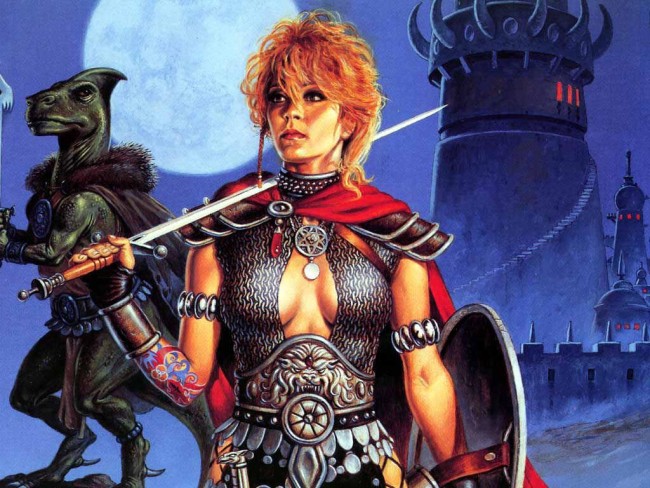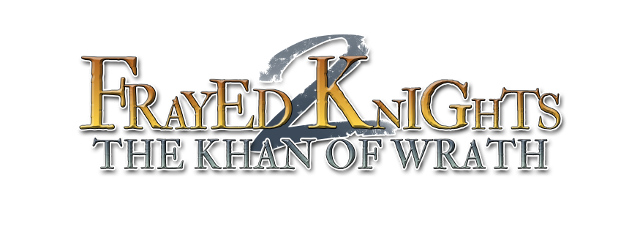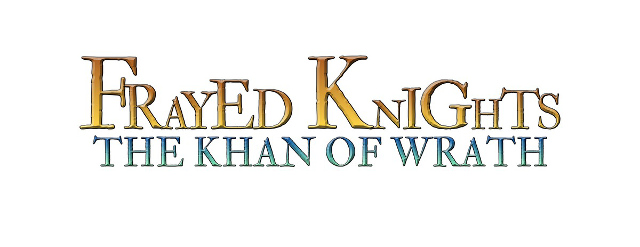Game Jam Games Gone Commercial(ish)
Posted by Rampant Coyote on September 2, 2015
It shouldn’t be an impediment to Game Jams, but one of my big hesitations is that it’s a distraction from my main project. I mean, if I’m gonna carve 48 hours or so of solid work on a game from my schedule, I’d be far better off focusing on the game I’m currently trying to finish, right? That’s the equivalent of two weeks of productivity right there! And besides, while it’s a great exercise to get practice in rapid development all the way through the release stage, it’s really a distraction from making the kinds of games that actually pay the bills, right?
Well, yes and no. There’s always the NEXT project, and what’s going to be the best project next time around? Wouldn’t it make sense to prototype a bunch of ideas quickly and see which ones fly first before committing weeks and months? Wouldn’t it make sense to have already done basic designs / prototypes for a dozen games and choose the one that is the most promising and exciting? Maybe turn that game jam effort into a full-fledged commercial project?
Well, that happens. I just wasn’t sure how often. I know that Ninjabee’s A Kingdom for Keflings kinda-sorta began as a “game in a day” jam inside the company called Rome. The two bear little resemblance to each other now, but the latter at least inspired the former.
I was aware of Receiver being not much more than a game jam title as well. And Goat Simulator – a game jam success story if ever there was one! And there’s the whole Amnesia Fortnight thing that Double Fine does, which has resulted in some successful commercial products, like Costume Quest and Stacking. But has there been anything else?
It turns out, quite a bit. Someone compiled a list of full video game releases that were based on game jam projects… and there are more than I expected:
A Non-Exhaustive List of Game-Jam Made Games
Most of these are not super-successful titles, but a lot of them were. I didn’t realize that The Binding of Isaac was originally a game jam project. Now of course, these titles required a whole ton of additional work and polish before being released as full-fledged titles, but it certainly helps to start with a proven concept via a game jam prototype, doesn’t it?
Anyway, I’m sure there are more, but I was pretty impressed by the list!
Filed Under: Indie Evangelism - Comments: 3 Comments to Read
[Archive] Of Game Engines and Swarm Missiles
Posted by Rampant Coyote on September 1, 2015
Editorial Note: This is an article that first appeared in the previous blog back in January 2006. Yeah, it’s old, but still valid. I’ve edited it to bring it up to date. Although I must admit, working with Unity has provided me with a lot fewer ugly surprises than some other engines.
In early 1995, I was working on both Warhawk and Twisted Metal for the then-upcoming Playstation (the first one) for Sony. Both games started with the same code base, and then diverged, but parts of the code (specifically the graphics and sound engines) remained shared between them.
We had a rather bizarre problem in Warhawk where suddenly everything would go haywire – usually when you were shooting the ever-popular “swarm missiles” at enemies. The cockpit would go “kittywampus,” matrices would get turned around, and sometimes the game would freeze. Since the symptoms almost always appeared when the player was firing swarm missiles, and I was the man who’d written the code for all the weapons, the bug fell upon my head to “fix the swarm missiles.” I had the bug on my list for weeks, and I had assumed (rightly so) that somewhere in my code I was clobbering memory that didn’t belong to me.
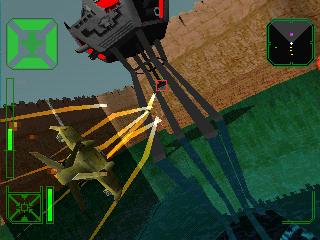 It was especially nerve-wracking, as the cluster of six swarming, bobbing, ‘flocking’ missiles dancing around each other as they shot towards a target was a major ‘seller’ for the game in demos, and you do not want the game to bug up during a demo! Our executives were told only to show the the swarm missiles in the “pyramid level” (level 1), as it was harder to cause the problem on that level.
It was especially nerve-wracking, as the cluster of six swarming, bobbing, ‘flocking’ missiles dancing around each other as they shot towards a target was a major ‘seller’ for the game in demos, and you do not want the game to bug up during a demo! Our executives were told only to show the the swarm missiles in the “pyramid level” (level 1), as it was harder to cause the problem on that level.
I was getting desperate one morning, and began tracking the logic through the engine code (We didn’t have very good debugging tools for the Playstation in early 1995 ). Now, this was an in-house engine — I’d mucked around in it before, and was familiar with the basic logic, but I wasn’t one of the principle engine developers. That honor belonged to some of the guys, headed up by Randy Zorko, who had spent several years at the simulation company Evans & Sutherland. These guys were used to working on multi-million dollar simulators for the military and civilian industries. They were also used to the limitations of these incredible super-computers.
As it turns out, one of the limitations they were used to was the number of “Coordinate systems” (read: independent, fully 3D models) in an environment. I think some of the best E&S systems could only handle something like 14 of these objects in the world at a time. So you’d have the user’s plane, and maybe six other planes, and potentially six missiles in the air at a time. So they’d created a buffer of these objects which you could acquire from the engine, and they guessed some astronomical number of models which the engine could handle – something like sixty. Because the number was something that sounded so huge to these guys, they decided they never really needed to test to see if you exceeded that boundary (although theoretically the function was supposed to return a failure if there were none left).
Any programmers reading this can immediately spot the problem.
Every time you fired the swarm missiles in Warhawk, you created twelve new “coordinate systems” in the game. Six missiles, and six contrails (which were models that were built on-the-fly, a trick I also used in Void War). When our executives were giving demos to people, they were always playing in “God Mode,” which gave you unlimited ammo and invulnerability. This meant they could fire a LOT of Swarm Missiles. It was quite possible to get three or maybe even four sets of missiles up in the air simultaneously. Add to that all the enemy planes, gun turrets, tanks, and enemy-fired missiles, and you can blow past that 60-CS boundary without too much trouble.
Randy was able to fix the problem in the engine in about five minutes, expanding the boundary to something like 90, plus fixing the check to make sure you didn’t blow past that (I don’t think we ever did, in the ten games or so that used that engine). And the Swarm Missiles became famous.
So is there the moral of the story?
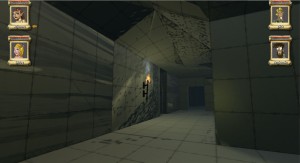 Not really. Just that as developers we’re always building on someone else’s foundation… even down to the O.S. level, and nothing non-trivial is bug-free. Whether it’s a full-on game engine or using a third-party piece of code. I absolutely love working with Unity, but even so I run into some major problems from time to time that I assume must be my fault, especially when the developers won’t acknowledge them (like light-mapping issues with the new light engine… grumble, grumble). I’ve had the problem with Microsoft APIs that are super-mature (albeit not super-popular) and have been around since at least the Windows NT days. How could someone else not have run into this problem before me?
Not really. Just that as developers we’re always building on someone else’s foundation… even down to the O.S. level, and nothing non-trivial is bug-free. Whether it’s a full-on game engine or using a third-party piece of code. I absolutely love working with Unity, but even so I run into some major problems from time to time that I assume must be my fault, especially when the developers won’t acknowledge them (like light-mapping issues with the new light engine… grumble, grumble). I’ve had the problem with Microsoft APIs that are super-mature (albeit not super-popular) and have been around since at least the Windows NT days. How could someone else not have run into this problem before me?
The trick is recognizing the problem for what it truly is. Beginners tend to be a little too quick to blame their tools, and sometimes the veterans may be a little too slow. Trying to figure out what to do from there… is it possible to fix it yourself, or get the developer to fix it, or can you come up with a work-around? Tough decisions.
Filed Under: Programming - Comments: 4 Comments to Read
Book Impressions: Dungeon Hacks
Posted by Rampant Coyote on August 31, 2015
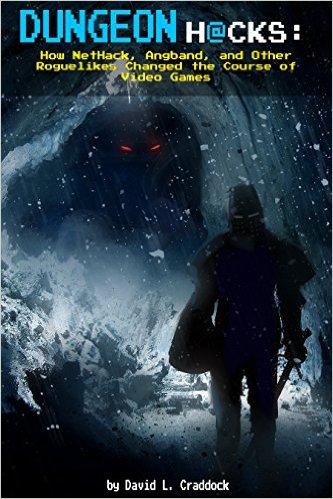 Except for a fairly lame mail-order game from Aardvark Software, my first computer role-playing game was Telengard for the Commodore 64. We didn’t have the modern taxonomy of games like we do now… I don’t know if “role-playing game” had really caught on then. “Roguelike” certainly hadn’t. Both words would have applied, but at the time, it was a D&D style game, and that was good enough for me. I spent hours and hours delving through the giant procedurally-generated dungeon.
Except for a fairly lame mail-order game from Aardvark Software, my first computer role-playing game was Telengard for the Commodore 64. We didn’t have the modern taxonomy of games like we do now… I don’t know if “role-playing game” had really caught on then. “Roguelike” certainly hadn’t. Both words would have applied, but at the time, it was a D&D style game, and that was good enough for me. I spent hours and hours delving through the giant procedurally-generated dungeon.
I didn’t know at the time that Telengard was heavily derived from a game on larger mainframe or mini-computers. But what I did learn was that the code was written in BASIC, which I was able to break into and examine in great detail to see how this giant dungeon with levels of 100 x 100 rooms could actually fit inside the 64K Commodore 64. That part wasn’t random – the maps never changed, but were rather calculated by a formula. But the content within the maps changed constantly. While it might not fully qualify, I consider it my first introduction to roguelikes.
My real introduction to roguelikes came several years later, with Moria. I never mastered it, never fought the Balrog, but I again spent many, many hours delving its secrets. While I found out later that Angband was its spiritual descendant, I never got into the latter game. At least not yet. While I’d briefly experienced other roguelikes, it was the one that “stuck” for me. In a lot of ways, it might have been because I didn’t think of it as a roguelike – I was thinking of it as an RPG.
Things have diverged a bit since then, with many roguelikes taking a more mathematically pure game-like approach, and others sticking with the more simulation-esque general RPG approach, some getting simpler, and others really going off in totally new directions while borrowing some of the key features from this family of games (the so called “roguelike-likes,” or as one friend coined the phrase, “Procedural Death Labyrinths”).
Last week I stumbled over a book that details some of the key games of the field, covering their history, interviewing key developers, and explaining what they added to the “mix” of roguelikes in the future. Well, duh, how could I resist:
Dungeon Hacks – How Nethack, Angband, and other Roguelikes Changed the Course of Video Games, is by David L Craddock. It’s divided into several sections. The main section goes chapter by chapter detailing various key historical “roguelikes” – including the games that preceded Rogue and of course Rogue itself. The chapters also have links to “Side Quests” – pieces of interesting history or trivia that didn’t belong in the main section, but could have easily been “sidebar” information. Finally, there is a section called “Bonus Round” that includes interviews with other people more peripherally involved in the history, and excerpts from other books.
My biggest words of praise for this book is the amount of effort the author must have taken to get in touch with these game developers and piecing together their stories – often dating back 35 years or more. I’ve always been interested in the story behind the development of games, even before I was a game developer myself. That’s probably a big part of the reason I decided to go into game development in the first place.
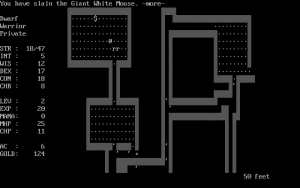 So if you are into that kind of thing, while the stories aren’t generally full of drama, they do offer fascinating insight into the people and the designs of these awesome classic titles. They offer insight as to why they were made the way they did, how people responded, what inspired the developers, and occasional bits of interpersonal struggles between the developers.
So if you are into that kind of thing, while the stories aren’t generally full of drama, they do offer fascinating insight into the people and the designs of these awesome classic titles. They offer insight as to why they were made the way they did, how people responded, what inspired the developers, and occasional bits of interpersonal struggles between the developers.
The “Side Quest” bits are fascinating excursions on their own. Some chapters contain lots of entries, others none or only one. But there’s little bits about the difficulty of sending software behind the Iron Curtain in the 1980s, or the “Lost” version 5.0 of Moria, or tidbits about the limitations of the technology or the weird university policies the developers had to contend with.
My one complaint would be that the promise of the title – how the key titles in the roguelike genre “changed the course of video games” – is largely unfulfilled. There is mention of some of the derived / inspired titles that have gained popularity today – the Diablo series, FTL, etc., but that’s largely left implied. As to course-changing… well, that might have been a bit overstated. I’d have liked to see more quotes from major game developers in the AAA and indie space today about how they were inspired by roguelikes or how a roguelike influenced their own designs. But admittedly, this is more of a quibble.
Anyway, it’s probably pretty obvious if the book would appeal to you or not. If you are interested in the history of the development of games, particularly RPGs and roguelikes, this is for you. If you are a roguelike fan, then you may be interested in the stories behind the development of the genre. If you are reading this and wondering “What’s a roguelike?” then I obviously I need to do my job better (although that question has some really contentious answers…).
Bottom line: I liked it, and it made me want to take a stab at building a roguelike more than ever. Maybe I’ll take some time out during the next 7DRL challenge, if it’s not coinciding with some major life event this time.
Filed Under: Books, Roguelikes - Comments: 2 Comments to Read
The Hugos: The Kindergarten Bestest Friend Award
Posted by Rampant Coyote on August 28, 2015
 I was going to write a big article about the 2015, and the travesty that went down this year with the Hugos. In fact, I did write not just one, but two articles about it. But I wasn’t happy with either one. In the end, I wasn’t really contributing much, in spite of both of them dwarfing this giant post. And I’m tired of the negativity.
I was going to write a big article about the 2015, and the travesty that went down this year with the Hugos. In fact, I did write not just one, but two articles about it. But I wasn’t happy with either one. In the end, I wasn’t really contributing much, in spite of both of them dwarfing this giant post. And I’m tired of the negativity.
If you don’t know what happened… well, good luck trying to get a straight answer. I’m a little biased, too, so I don’t know if my take on things is any better. I’ll just say… the Hugo is about science fiction and fantasy, and most of the stories bandied about by even the supposedly professional media were far more fantasy than anything else.
I was a voter this year for the Hugos, which was pretty meaningful to me, as the award had been meaningful to me when I was growing up. I haven’t paid too much attention later in life, and found many of the award-winners of recent years to be quite divergent from my tastes. I think the awards have diminished in value and prestige over the years, and there may be kind of a weird causal relationship there. But I think most of the “diminishing” has been because fandom has grown and expanded so much that the convention that it belongs to (WorldCon) is no longer the hub of all things SF/F-related as it once was.
There are people who still care about it and stay involved, and – over the years – have some pretty solid influence over how the Hugos get awarded each year (in spite of downplaying their own influence). They have their tastes and their relationships, and those have influenced their gatekeeping “duties.” That’s group 1. Group 2 was a smaller group that thought the Hugo ought to change, and needed “fixing” to be less hidebound and more reflective of the larger interests of expanded fandom as a whole, and should be big enough that no group should really be in control of it at all. Group 3… I don’t understand as well, but for the most part they seemed interested in making sure that Group 1 didn’t have control of it any longer, even if that meant blowing up the Hugos so it was useless to everyone. Finally, there were people that weren’t really in a “group” but were the ones who either tried to stay above the fray or neutral about it, or in spite of their involvement in WorldCon didn’t really know much about what was going on.
Anyway, certain folks in groups 1-3 wanted to turn it into a holy war, particularly this spring when group 1 discovered that many of the people they’d anointed to be nominees this year didn’t actually make the ballot. By turning things into a holy war, the ends somehow seem to justify the means, and people desperately wanted the “must fight evil!” excuse to justify their extremely nasty, unethical actions. Group 4 just wanted to know why everyone couldn’t just get along. And the media made up their own stories, grabbed popcorn, and watched high profile geeks turn on each other with escalating levels of viciousness.
Feelings were hurt. Careers were hurt. Violence was threatened but fortunately never materialized. Straw men were built and kicked over. The squabbling was some of the nastiest stuff I’ve seen since Junior High. In the end, people were recruited (in some cases, bought and paid for) on multiple sides to help make sure “their side” won. Or just to make sure the other side(s) lost.
In the end, I think the Hugos themselves and the quiet fourth group lost. The Hugos were proven to be little more than a kindergarten “bestest friend” award, and have probably lost whatever legacy prestige they still retained. I really can’t see how anyone can treat them seriously in the future. The “real” fans who took their role in the awards seriously (scattered throughout the factions, but many making up the fourth group) found themselves marginalized.
The second group got kicked to the curb with extreme prejudice (again), the third group managed to achieve a dubious win condition, and the first group stood the next day over the smoldering carnage of the earth they’d scorched and asked, “What have we done?!?!?” Many recognized that while they might have survived the battle, they’d probably lost the war, even as others on their side were cheering that they’d held off the barbarian invasion one more year. Kind of.
And the media got to jeer at the geek civil war.
Bleah. All that negativity. Believe it or not, that’s my highly abbreviated take on what happened.
So… on to better things. Here’s what I was good about the whole experience for me:
First of all… as a Hugo voter, I got a ton of awesome reading material. Too much, really… I spent waaaay more time going through it all this summer than I really had at my disposal. But for the price of admission, it was more than worth it. Yeah, a few entries (from all nominating groups) kinda left me cold. But for the most part, there were some awesome stories.
For my favorites… almost all of the novels were excellent. The actual winner of the “best novel” award (the one where Groups 1 and 3 actually agreed… mainly because group 1 didn’t know that group 3 liked it…), The Three-Body Problem, is well worth reading. My favorite was Skin Game, but I’m a Harry Dresden fan.
Of the other works… I really liked Ms. Marvel, although I couldn’t shake the feeling that the choice of a Muslim-American superhero was more politically motivated, calculated attention-getting move than it would have been two decades ago. Still, regardless of motivations, it was good.
I really, really loved The Plural of Helen of Troy. It’s a story about a city run by… well, effectively “Time Lords,” although they have a different name. But imagine a society where nothing happens without the approval of time-travelers who can go back and change anything they didn’t like. Celebrities of different eras thrust together in apartments. It is a wonderfully brain-twisting mystery where past, present, and future all get munged together.
Big Boys Don’t Cry by Tom Kratman and Totaled by Kary English were two other stories that really impressed me. The former is sort of military SF with a harsh commentary about the application of the military in today’s global poltical arena. The latter is a “brain in a jar” story that asks some hard questions about the value of human life when life can be extended after the body has died.
There were several other enjoyable works, but those really stood out for me, and I wanted to share.
On top of that, I was introduced to people and authors that I may not have met had I not been involved (even if only up in the nosebleed section). While I’d like to believe it would have happened anyway, being involved served as a catalyst.
I guess you could say it was also pretty educational. While I may have learned more than I really wanted to know about a couple of people whom I previously admired, I got the chance to learn a lot more about the industry, the major players in the field, the history of fandom, and so forth.
I was once again reminded why you should be very skeptical of anything you read on the Internet. Even from (or especially from) supposedly reputable, professional journalism sites. There’s nothing quite as breathtaking as being an eyewitness to the facts, but then seeing completely manufactured, provably invalid falsehoods take wing at the speed of light and take on a life of their own. There’s the old joke, “Who are you gonna believe, me, or your own eyes?” but it’s really not a joke. Gaslighting is a thing, and it works. So… guard your mind. And never assume that the truth must be somewhere “in the middle” (a common assumption that I make way too often).
And in the end… this tempest in a teapot notwithstanding… I have come to the realization that science fiction & fantasy, as a whole, are doing just fine. Just like the video games biz, we’re encountering challenges and struggles over growth and change. These are healthy problems to have. Just by looking at the sheer volume of material being published now as opposed to when the Hugo awards first became a thing, and that tells you a lot. Fandom is much, much bigger and more diverse, and we have far more outlets to enjoy being together in their shared enthusiasm.
And while Sturgeon’s law still applies, I think the best works of the speculative fiction genres coming out each year are as good as ever, and are obviously more plentiful. While I haven’t been too pleased with some of the award-winning fiction of the last few years, I have come to realize that this was a matter of the taste of the gatekeepers (acting a little like editors), not necessarily indicative of the entire field. There’s a heck of a lot out there, and it is diverse and fun and exciting.
This was neither the first of the fan arguments about the future of the field, and I’m sure it won’t be the last… and sadly, probably not the nastiest, either. SF/F authors are all about making larger-than-life drama, and this was one of them.
I don’t know if I want to be a participant next time like I was this time… particularly for an award that I think has effectively self-destructed… but I might. If nothing else, it’s a relatively cheap way to get to read some of the year’s best SF/F.
Filed Under: Books, Events - Comments: 10 Comments to Read
That Old School Feeling: Forgotten Realms and Divinity: Original Sin 2
Posted by Rampant Coyote on August 27, 2015
I’m gonna post a two-for-one today, because it’s all so cool.
Number one: A great article from PC Gamer about how GOG.COM rescued thirteen Forgotten Realms D&D games from licensing hell. It’s both fascinating and a little disturbing as a retro-gamer. You think, “well, gee, why haven’t these guys gotten around to licensing this game yet,” and that’s why. The rights don’t necessarily go to with the merger / acquisition, especially where bankruptcy is involved. And in some cases, the owner of the rights might not even know they own the rights, or have any idea what it is even if they stumble across it going through old filing cabinets.
It’s also a decent cautionary tale about DRM. Perfect DRM means a game perfectly self-destructs when its caretakers hit a bump down the road, no matter how well-meaning they are on the game’s release. How many of these companies that seemed to be on top of the world in their heyday have gone the way of the dodo now, their assets scattered or forgotten? A lot.
Anyway, if you haven’t snagged them yet, GOG.COM has the awesome D&D games of yesteryear – the Forgotten Realms Gold Box games, Hillsfar, Forgotten Realms Unlimited Adventures (build your own gold box game!), the Eye of the Beholder series (BOOYAH!), Dungeon Hack, and Menzoberranzan. Sadly, not (yet) the Dragonlance or Buck Rogers gold box games, or the Ravenloft games. Hopefully they are pursuing these other licenses as well. But honestly – if you can handle the ancient DOS era interfaces (the latest of these games was published 20 years ago), they are way, WAY worth it, and represent hundreds of hours of old-school RPG goodness.
(Decades later, I still love the picture of Alias from the cover of the game & novel, but her stupid armor still fires off some OCD part of me that wants her to wear padding and find the missing centerpiece!)
Next up, we go from the awesome classic old-school games of the past to the awesome old-school-feeling games of the present. Divinity: Original Sin 2 is now in crowdfunding phase and has surpassed its funding goal on the very first day. The first game was excellent. The second game promises improvement over the first game, naturally. But it also offers up to four people playing at the same time – which is cool – and a major emphasis on role-playing… especially the ability to to switch seamlessly between cooperative and competitive gameplay.
Even more importantly (for me), competitive gameplay does not (necessarily) mean direct PvP. They are trying to go all-out on narrative design, and working against your fellow players may be all about pursuing a different end via quests and so forth.
This was pretty much an insta-backing for me, and I have a lot of faith in Larian as a studio, but that’s me. Your mileage may vary, but if you are interested, here’s the link:
Divinity: Original Sin 2 Kickstarter
Filed Under: Game Announcements, Retro - Comments: 2 Comments to Read
How “Old School” Graphics Worked
Posted by Rampant Coyote on August 26, 2015
Oh, man. This brings up some memories. I worked with the Commodore 64 graphics for years. Never produced anything commercial, but I certainly struggled with these challenges.
There’s something he doesn’t bring up in the video about the Commodore 64’s sprite mode. Each sprite had its position dictated by two bytes – one for X position, one for Y position. Now, if you are a programmer, you can recognize that there’s a problem with 320 x 200 resolution… there’s more horizontal screenspace than can be represented by a single byte. So there was another value you’d have to tweak to set the “seam” bit which acted as an extra bit of information that set the value to 256+the X value. Basically it expanded the horizontal resolution to 512 instead of 256. It was kind of a pain in the butt to work with, especially in BASIC.
There’s a reason why old-school games were so driven by tech and programming. It took a lot of fancy code to get those graphics to work, and at speed.
Filed Under: Art, Programming, Retro - Comments: 3 Comments to Read
The Easiest and Most Challenging Songs in Rocksmith 2014
Posted by Rampant Coyote on August 25, 2015
 Rocksmith 2014 has a pretty huge library of songs at this point, particularly if you include imported songs and DLC from the first game. It fortunately includes songs with a wide range of difficulty levels, although in many cases that really depends on what part you play. The “average” song is easiest on bass, harder on rhythm, and hardest on lead. But there are a lot of deviations from this, including songs where the bass gets the biggest workout.
Rocksmith 2014 has a pretty huge library of songs at this point, particularly if you include imported songs and DLC from the first game. It fortunately includes songs with a wide range of difficulty levels, although in many cases that really depends on what part you play. The “average” song is easiest on bass, harder on rhythm, and hardest on lead. But there are a lot of deviations from this, including songs where the bass gets the biggest workout.
Trying to define what’s easiest and what’s hardest is its own challenge, because what’s easy for one player to pick up may be difficult for another. Switching between certain chords quickly? Accurate string bends? Rhythm timing?
Of interest perhaps to nobody but myself, I put together my personal list of what I consider the easiest and the most challenging songs currently available in Rocksmith 2014. The easiest would I guess be useful for new players looking for something within their grasp to master. The most challenging ones… well, those are my holy grail. I figure if I can master those, I can have no problem playing anything with or without the game. At least until the guys at Ubisoft manage to license some tunes from Dragonforce.
I focused on lead guitar parts, since that’s what most players focus on. There are probably a few rhythm parts that are arguably easier than what I have listed – but not by much. Bass is a whole ‘nother story of easy. I’ve hit 100% my first time playing some bass parts, which I never do with rhythm or lead guitar.
Another thing to note… playing a song accurately for Rocksmith isn’t the same as playing it well enough for human listeners. It gets you in the ballpark, but RS 2014 actively strives (by default) to wean you off the game, committing a song to memory so you can play it without the game, to be judged only by human ears. Just like guitarists have done for centuries.
Easiest Songs:
If you are new to guitar and want tolearn to play a song note-for-note as it appeared in the original recording, these are good candidates. They are easy enough for beginners to tackle, and even master with a reasonable amount of practice. And they are good for getting some platinum picks in your score attacks.
Next Girl – The Black Keys (RS1 Import): This is a the one song I came perilously close to nailing with 100% accuracy at full difficulty the first time I played. It’s simple, single-notes, and plays at a relaxed pace. The only real special skill it requires is a basic hammer-on (and it’ll register success even if you strum it, so “requires” is a very loose term).
Blitzkrieg Bop – The Ramones (RS2014): Four two-finger power chords. Other than nailing rhythm and upstrokes, there’s really nothing to this one. It can’t get much easier.
My Girl – The Temptations (RS1 DLC): “I’ve got sunshine on a cloudy day…” This is a classic soul / rock hit from 1964, with a pretty familiar riff even for those of us born long after the song was popular. It’s a simple riff and 2 & 3 note chords on the higher strings, but even with the key change it goes at an easy pace for a beginner to keep up (and memorize!). The rhythm part is even easier.
Song 2 – Blur (RS1 Import): This one has a few more two-finger power chords (double stops) and a double-stop octave with a skipped string that you’ll need to learn to mute. But otherwise, it’s only marginally more challenging than Blitzkrieg Bop.
All the Small Things – Blink 182 (RS1 DLC): This is probably more difficult than the other four, and at this point you can probably name several other songs that are approximately as easy. It kinda-sorta has a solo (using all of two notes), and is faster than My Girl, but it’s still a good, catchy piece to practice to master the chart.
Hardest Songs:
I have less to say about the hardest songs on the list, mainly because they are so hard I can’t manage more than about 25% mastery, if that. Fortunately, thanks to the game I can kinda-sorta play along and sound lile
For the Love of God – Steve Vai (RS2014 DLC): Extremely technical. It starts out slow and gives you the false hope that you can maybe manage it. And then shred happens. I believe the title of the song is what many people exclaim as they try to master this monster.
Cliffs of Dover – Eric Johnson (RS1 DLC): The previous reigning champion for difficulty, although many still feel it’s the hardest because it is kind of weird and ever-changing. It’s also a piece that just brings a smile to my face every time I listen to it, and even as I’m doing my best to play along. Like For the Love of God, it’s a song that’s pretty much one giant solo.
Death Mental – Golden Bomber(RS2014 DLC): This would be challenging at half the speed. I’d never heard the song before Rocksmith (true of most Japanese music), but man, it’s an awesome crazy old-school speed metal shred for those of us still waiting on Yngwie Malmsteen and Dragonforce.
Satch Boogie – Joe Satriani (RS2014): Arguably the most challenging of the songs that came included with Rocksmith 2014, by the master rock guitarist who taught legends like Steve Vai.
Hangar 18 – Megadeth (RS1 DLC): Half the song is solos. Be grateful it’s only half.
So there you go. I think those songs paint a pretty good picture of the extremes. There may be other songs that are just as easy or just as hard, which could have fit easily in my lists. But I think you’d be hard pressed to find songs that are significantly more easy (on lead) or more difficult.
Fortunately for people like me, there’s a whole lot in-between.
Filed Under: Guitar Games - Comments: 2 Comments to Read
Video: Indie Game Devs at Salt Lake Gaming Con 2015
Posted by Rampant Coyote on August 24, 2015
Salt Lake Gaming Con may be a couple of weeks in the rear-view mirror now, but some interviews and reports are still coming out.
Here is a set of interviews conducted by From Beggar’s Canyon with the Utah Game Guild folks. If you want to skip to the part with Yours Truly, you don’t have to go too far… I make an appearance just over three minutes in talking about Frayed Knights 2: The Khan of Wrath.
Filed Under: Events, Frayed Knights, Indie Evangelism - Comments: Read the First Comment
Good Crunch and Bad Crunch
Posted by Rampant Coyote on August 21, 2015
Crunch is when people working on a project put forth the “extra effort.” It’s long hours, late nights, sacrificed weekends, and often heightened tempers. I’ve done my share of crunch, both inside and outside the games industry. I’ve done crunch as a game developer both as a full-time employee and as an indie. I could perhaps make the argument that as a part-time indie who makes games as a side job, all I do is crunch. But there are ways to manage that.
With arguments going around once again about the evils of crunch time, I thought I’d posit that there is actually such a thing as “good crunch.” In fact, it might be best to talk about good crunch first, because bad crunch is pretty much defined as “any kind of crunch that isn’t the good kind.” Or something.
“Good Crunch”
Crunch time, in my mind, is that period where extra effort is needed. It happens. Crunching for the last couple of weeks before a major milestone? For games, I suggest that this kind of crunch might be unavoidable. There are two factors that multiply together to make this a reality in a healthy environment.
#1 – Game developers are invested in their work (and, theoretically, have a stake in its success). This is how it often was in the old days, and this is how it often is in the indie world. So the developers themselves are self-motivated to make sure what they are making is of highest quality possible.
#2 – Game development is a somewhat open-ended endeavor: Games are never really “done.” Just shipped. But up to a point, a little extra effort can make positive improvement in the title. And… in a competitive, hit-driven environment, this might be what the game needs to stand out at a trade show, for a Kickstarter pitch, or a release.
And let’s face it… crap happens, even in a perfectly managed situation. If the situation calls for a “crunch” due to being behind schedule in some way, in a healthy environment this should be accompanied by a long, hard look at scope and requirements. Ideally, the goal post should be moved back a bit as well as the developers pouring on the coal to get things back on track. In other words, when things start getting behind schedule, crunch is only a tool to deal with immediate symptoms, and another cure for the fundamental problem must be found in conjunction with any crunch.
“Bad Crunch”
But there’s a dark side. We know about some of that. Management abusing developers. Mandating crunch. Using crunch to paper over management failures. That kind of thing.
When you have a company that operates in a mode where that is the rule rather than the exception, something is horribly wrong. When 60 hours minimum is mandated for weeks or months on end (been there), something is badly, badly broken. When I hear people going off on “crunch” in the industry, that’s what I think of. That is a failure of management, and an abuse of employees.
Worse than that, crunch mode is something that is counterproductive after a relatively short time. Sure, some developers are machines that can operate at 60 hours a week for months on end with no drop in performance (or so I hear…), but most people can’t do that. In fact, within a week or two, most people’s productivity during extended hours begins to decline, in many cases dropping down below their performance during normal hours. Crunch is supposed to be “extra effort,” and it can only work (if at all) when it truly is “extra.”
When the developers are judged by the amount they crunch – showing “dedication to the project” or whatnot – then things go bad really quickly. That doesn’t encourage good work or dedication, it encourages visibility at the office at long hours; simply butts occupying chairs. It may damage some tender but vague ideals of “fairness,” but ultimately it has to be a meritocracy — how much every person is contributing and producing, regardless of extra hours worked beyond the required 40 (or less, in the indie environment).
“Healthy Crunch” vs “Unhealthy Crunch”
Maybe calling crunch “good” is pushing things a bit too far, so I’ll call instead call it “healthy.” A healthy crunch is one that occurs in a team that has a healthy, sustainable approach to doing business.
- A healthy crunch is fueled by passion. An unhealthy crunch is used as a proxy for passion.
- A healthy crunch is developer-driven as a tool to accomplish objectives. An unhealthy crunch is an objective unto itself and driven by management.
- A healthy crunch is short. Anything longer than a couple of weeks at a stretch should be considered unhealthy by default.
- A healthy crunch is an exception to the rule, reserved for emergencies or major milestones. If it’s a frequently- or regularly-applied tool, it no longer represents “exceptional effort” and not only loses its effectiveness, it becomes downright unhealthy.
- If milestones cannot be reasonably achieved without any crunch whatsoever, the entire project is unhealthy.
In moderation, in certain periods, a little extra “oomph” for a couple of weeks here and there can be a positive experience. It can be used for a quick sprint for a milestone. It can be used to build momentum, which can be critical for morale during those long, dark mid-stages of development where a lot of work yields little apparent results. And – in conjunction with bigger, better tools – it can be used on an emergency basis to get a schedule back on track. But in every case, this “healthy crunch” is something that developers must do on their own.
Filed Under: Biz, Production - Comments: 5 Comments to Read
Li’l Snarfquest Crowdfunding Campaign
Posted by Rampant Coyote on August 20, 2015
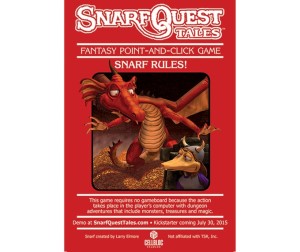 The truly “old school” among us may remember SnarfQuest, the humorous fantasy comic that graced the pages of Dragon Magazine back in the 80s, created by legendary fantasy artist Larry Elmore. As I mentioned many months ago, there is an actual game in development featuring the beloved zeetvah.
The truly “old school” among us may remember SnarfQuest, the humorous fantasy comic that graced the pages of Dragon Magazine back in the 80s, created by legendary fantasy artist Larry Elmore. As I mentioned many months ago, there is an actual game in development featuring the beloved zeetvah.
As Larry himself has explained, any resemblance of the beloved zeetvah with a particularly unloved character in somewhat disappointing prequel series to a much-beloved science fiction trilogy is… well, if it’s not coincidental, it’s not his fault, as Snarf came first.
SnarfQuest Tales is an adventure game, and the demo is out now. But the creators are requesting crowdfunding cash to make the full game. I don’t know anything about them, but I do love SnarfQuest.
So… I thought I’d pass it along. The campaign has about two and a half weeks left to go, and is more than two-thirds funded, so it’s likely to make funding.
Filed Under: Game Announcements - Comments: Comments are off for this article
RPG Design: Granular Experience Points
Posted by Rampant Coyote on August 19, 2015
Some people I know have dropped the concept of experience points from their D&D / Pathfinder campaigns. They simply allow the players to level up their characters at appropriate times.
Is this a revolting idea to me, as an “old school” D&D (Dungeons & Dragons) player? Nah, not really. Sure, I think the game is missing something without it, but I’ve run games like that myself. Other game systems, but sure. There’s no problem with awarding experience points – basically a marker for tracking improvement (or spending directly on improvement, in many skill-based systems).
In fact, one can ask – what is the purpose of having the finer resolution of traditional, D&D-style experience points?
I’m glad one asked! While I love it simply as a matter of tradition, there’s more to it than that. Here are several reasons. Several of them reflect an inherent understanding of game design on the part of the original designers. Maybe these factors came about by chance, but I think the style of game we all enjoy gained popularity specifically because of these elements.
First of all, the obvious – it allows finite but measurable progress in a game system that doesn’t offer frequent improvements. A single battle may not impact things by much, but a dozen? Unfortunately, this particular element was perhaps overly exploited by early D&D players, giving the game its bloodthirsty reputation. After all, every little kill counted, right?
Secondly, it allows unequal, non-linear progress. This was especially true in earlier editions of D&D, which tended to suffer higher character mortality rates. A series of encounters that would barely move the needle for a high-level character (back then, 8th level or so was pretty high) might bring a new character up to 2nd or even 3rd level. Thus, after a couple of adventures “mentoring” a new character, they were quickly brought up to a level where they could pull their own weight, and yet the more advanced characters still enjoyed a little bit of measurable progress.
But on another front – rather than giving such a direct, linear bonus to character actions, in the old days a higher attribute score would give a character an experience point bonus. So a Magic User with a very high Intelligence score might progress 10% faster than normal. So he or she might have started out relatively equal to everyone else, but the 18 intelligence magic user moved to the head of the class faster. In order for that bonus to be useful, XP had to be doled out in chunks large enough that 10% meant a reasonable whole number. Now, I can’t say that I was really fond of the unequal progress mechanic (and since it has largely gone the way of the dodo, I guess I wasn’t alone in that), but it was at least an interesting approach.
Now, for anything else to be meaningful, experience points had to be something in some level of control by the player. In modern games, so much seems to be left in the hands of the game master, even to the point of scaling encounters up or down to match the character level, it might make sense not to bother with incremental XP. But in the old days, a chunk of the experience points were solidly in the player’s hands. Maybe they didn’t know what points there were to be had, and there were no guarantees. The bulk of the experience point award came from the accumulation of treasure, and that was notoriously well-hidden, trapped, and / or disguised back in the old days. That was the POINT. If the game were played as intended, something like a third of the experience point potential was not obvious.
So third – it means that XP can be a direct reward for player-driven exploration and clever play. In some cases (particularly in modern computer and console RPGs), it gives the player the chance to decide whether or not to push forward to bigger challenges, or to stay at the current level (these days, it might mean to “grind for XP,” but that’s not necessarily the case). It also drove some pretty sociopathic character behavior, killing everything in sight to squeeze out the last few experience points. But this third point is perhaps the most powerful of them all… it puts more of the progress of the game in the player’s hands.
In the end, it really depends on the kind of game players want to play. While I prefer the more traditional method with the advantages it confers, I still enjoy systems where the leveling is more of a scheduled event, or a system like Hero or Storyteller where experience points are few and directly used for character building. Since character progression is one of the major defining elements of an RPG, it exerts a major influence on the flavor of the entire game system.
Filed Under: Design - Comments: Read the First Comment
The Windows 10 Game Denial Scenario
Posted by Rampant Coyote on August 18, 2015
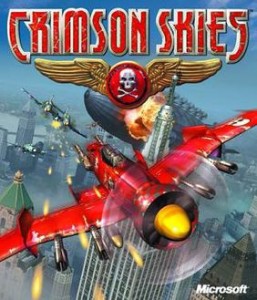 I haven’t upgraded to Windows 10 yet. I will have a laptop with Windows 10 in a few weeks, and I may eventually upgrade my desktop. I avoided the Windows 8.x fiasco entirely. I don’t particularly trust Microsoft, though I don’t harbor any resentment towards them. I’m still of the opinion that Windows will no longer be my “primary” (and never my “only”) launch platform for games… which is a matter of distrust rather than dislike.
I haven’t upgraded to Windows 10 yet. I will have a laptop with Windows 10 in a few weeks, and I may eventually upgrade my desktop. I avoided the Windows 8.x fiasco entirely. I don’t particularly trust Microsoft, though I don’t harbor any resentment towards them. I’m still of the opinion that Windows will no longer be my “primary” (and never my “only”) launch platform for games… which is a matter of distrust rather than dislike.
That’s natural. They are a big company. The guys in charge of various divisions change pretty regularly, and each new regime change brings a whole new personality. And as a whole, Microsoft’s corporate goals do not align to my own. Why would they? Where their goals align with mine (for the time being), awesome. Where they don’t… well, I have to make sure I limit my dependence on them.
Anyway, my delay of upgrading to Windows 10 was at least in part due to the fact that I had a big demo to pull off in the middle of the upgrade period, so there was no way I was going to throw that particular variable into my preparation for Salt Lake Gaming Con. Once again… limit my dependence. I don’t consider myself particularly paranoid (especially when I assume it’s not paranoia when they really are out to get me… 😉 ). But I find this pair of news bits about the unexpected “features” of Windows 10 to be… amusing in combination.
First off… this report that the new EULA specifies that Windows can detect and automatically remove cracked / pirated versions of Microsoft products. Like, games. Okay. Considering how Microsoft still doesn’t like to recognize or accept the fact that I have an older version of Microsoft Office that I like to reinstall on newer machines, I really don’t have warm fuzzies about the potential here, but so far it’s just potential.
But wait, it gets better: Windows 10 won’t run games using certain DRM! Oh, well, we knew that was coming, didn’t we? We retrogamers have been worried about this for a long time. Ah, well. In most cases, we can find a hacked / pirated version of games *we already own* if we feel the urge to play them again. I’ve always resented the fact that pirates ended up with superior versions of the games I bought legally, and that sometimes I had to resort to downloading sketchy patches from sometimes even more sketchy websites to get my legally-purchased game to work.
But what’s this? Some of the games that have this awful DRM were… Microsoft Games! Including several that I own (and at least one that I still play). So… in theory, not only will it no longer run on modern versions of Windows, but Windows may automatically delete it if I try to hack it so it does run!
Okay, now, in all seriousness, I have major doubts Microsoft will take such steps to make sure their decade-old (or older) products no longer function whatsoever. It doesn’t make any kind of business sense, but there’s always a chance you’ll get some peevish anal-retentive person heading up the organization in charge of such things long enough to screw things up for a while. But I was amused by the one-two combo.
Filed Under: Mainstream Games, Tech - Comments: 4 Comments to Read
Plan: Finishing Up August, and a Frayed Knights Question
Posted by Rampant Coyote on August 17, 2015
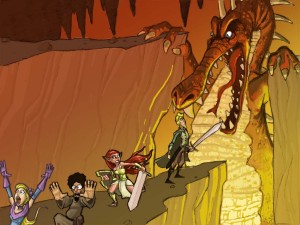 Now that the two conventions are done (WHEW), the remainder of August… well, remains busy, but a little less so. Here’s what’s going on…
Now that the two conventions are done (WHEW), the remainder of August… well, remains busy, but a little less so. Here’s what’s going on…
This week, my daughter gets home from South Carolina, where she’s been serving as a missionary for the Church of Jesus Christ of Latter-Day Saints for the last 18 months. We’re excited to get her back home, although she’ll only be here less than two days before we take her off to college again. That’s going to make the latter part of this week pretty busy.
Until then (and all the following week), I’m working on my demo for Frayed Knights 2: The Khan of Wrath for Utah Game Wars. The submission deadline is the end of the month (Monday the 31st). While it’ll be a little crazy, it won’t be as crazy as preparing for the ToshoCON and Salt Lake Gaming Con demos. Mainly what needs to be done – aside from fixing some embarrassing glitches – is to get everything back to its keyboard & mouse driven default (for conventions, handing people a game controller is easier), providing instructions since I’m not there to manually explain things, and fixing issues where I needed to guide people around in the live demos.
I’ve got an aggressive development schedule between then and the new year. Plus writing projects. And I came to the realization that if my planned schedule is anything to be believed (HAH! HAH, hahahahahah!), I have to start ramping up the marketing stuff for Frayed Knights 2: The Khan of Wrath.
Which brings up a question I wanted to ask before the principal audience – you guys. Do I keep the “2” or drop it? I have worked hard to make the story in the sequel stand on its own, and it’s such a major improvement over the original – and will be available on more platforms – so that I don’t want people to feel they can’t play it until / unless they’ve played the original. As much as I’d love for this game to help drive sales of the first game, I don’t want it to be restricted by the sales of the first game, either.
So what say you folks? Should I keep the “2”, or just call it “Frayed Knights: The Khan of Wrath?” And why?
Filed Under: Frayed Knights, Rampant Games - Comments: 7 Comments to Read
Utah Unity User Group Meets
Posted by Rampant Coyote on August 14, 2015
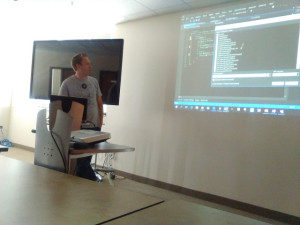 Last night was the inaugural Utah Unity User Group (with the rather amusing acronym UUUG). I found it even more informative than I expected.
Last night was the inaugural Utah Unity User Group (with the rather amusing acronym UUUG). I found it even more informative than I expected.
The group included experienced Unity users as well as interested newcomers, so the skill level was pretty varied.
Jeff Postma’s formal presentation on Unity’s new 2D tools was valuable as expected, since I have been using a third-party library and haven’t really done any research on what the new system is like. This was a useful introduction to how it all works. Maybe it wasn’t useful to some of the old hands, but I appreciated the overview.
I ended up showing the demo for Frayed Knights 2, which I wasn’t expecting. I realized I had my laptop in the trunk of my car, which had a somewhat older build than the one I’d used at Salt Lake Gaming Con. It might have been the build from ToshoCon or slightly earlier. Either way, it doesn’t run very well on my 5-year-old laptop (which was a refurb when I got it), which is disappointing. I seem to recall an earlier version running faster, but maybe that was in a simpler level.
I also got to play another Unity game that was whipped up in apparently just a couple of weeks. I’m sorry, I totally forgot the name of it though. Something like Alien Landers or something like that. It’s a WIP name anyway, but the game was pretty fun to play.
As is usual with these kinds of events, the best part is actually talking to other people and swapping thoughts, sharing ideas, and just getting to know who’s who in the community. I guess that is called “networking” which makes it sound much more formal and intimidating than it really is, for those new to this kind of thing. For the most part, we had fun swapping “war stories” and talking games, and any excuse to do this rates high in my book.
We have to be a little careful, because with all these meetings and events happening here in the Salt Lake City area to support indie game developers (Utah Indie Night, UDEN, this, and some of the other things popping up) we could actually swamp our prime development time, and there’s actually some challenge making sure these events don’t conflict with each other and with major events happening elsewhere. But I take it as a sign that the game development community here in Utah – and the software development community in general in the area – is thriving and growing.
Good times!
Filed Under: Events - Comments: Comments are off for this article
“Cold Spot” 777 Challenge
Posted by Rampant Coyote on August 13, 2015
 I was tagged by Nicole Payne for the “777 Challenge.” The challenge is to share 7 lines from page 7 of one of your manuscripts and tag 7 other blogging authors to do the same.
I was tagged by Nicole Payne for the “777 Challenge.” The challenge is to share 7 lines from page 7 of one of your manuscripts and tag 7 other blogging authors to do the same.
Okay, I’m game. Although next time, I should probably make sure that I have more action-packed scenes on page seven. Bear in mind, this is still in the editing stages right now, although we’re getting close to the end of that process. Fun!
(Shameless plug inbound: You can check out two of my previous short stories in Terra Mechanica: A Steampunk Anthology and in Mechanized Masterpieces 2: An American Anthology
.)
This is from my story “Cold Spot” in the soon-to-be-announced Xchyler paranormal anthology. The two main characters, Mike and Nate, are trying to figure out how a laptop computer could have been stolen from inside a locked office with two people in the room. Nate proposes a disturbing possibility:
“I used to read these short mysteries when I was a kid, the ones where you had to look on another page to see if your solution was correct. I remember one about how this guy was stabbed through the heart, but the police had to bust the door open because all the doors and windows were locked from the inside. So how did the killer get away?”
“Um, the guy committed suicide?”
“Nope. The trick was that he hadn’t gotten away. The killer was still hiding inside the house.”
“Hold on. There’s no way a thief would still be in the office.”
So now the seven people to tag. I’m gonna go with Melissa McShane, Jana S Brown, Craig Nybo, Sarah Seeley, John M Olsen, J R Potter, and J. Aurel Guay.
Filed Under: Books - Comments: 2 Comments to Read
Rocksmith: The Bands I’m Waiting For (But Not Really)
Posted by Rampant Coyote on August 12, 2015
 Time to get away from conventions, Frayed Knights, and even RPGs and indie games for at least one post…
Time to get away from conventions, Frayed Knights, and even RPGs and indie games for at least one post…
My at-least-a-half-hour-a-day Rocksmith 2014 habit has taken some hits recently, mainly due to preparation for the convention. At a half-hour a day, I find my skills don’t really increase much from week to week (but they don’t atrophy, either). However, if I miss a couple of days in that schedule, it impacts my playing.
Although it’s kinda cool just pulling the unplugged guitar into my lap and just going through scales or practicing some riffs. I can’t say I’m completely comfortable with the guitar or have made it an extension of myself or anything cool and musician-y or anything. But I can say I do have a comfort zone now. It’s not a big one, but I keep trying to push it.
And speed…. yeah. The dreams of my sixteen-year-old self of playing like Yngwie Malmsteen are probably not going to happen. At least not within the next couple of years, at this rate. The whole “rock star” ship sailed off a long time ago. I’m good with that. Now I just wanna have fun, play along with songs, and jam with friends. ‘Sall good.
For their part, Ubisoft has done a very good job of keeping Rocksmith 2014 alive. Seriously, while I have a few wish-list items for improvements and a couple of highly desired features (like being able to put together custom playlists!), they are really just embellishments to a very solid product. At this point, even if the DLC were to be cut off completely and the game retired, I’d probably be playing Rocksmith 2014 well into 2024 with what I’ve got.
But everybody’s got a wish list for songs or bands they like to have in the game. And in the last six months we’ve gotten some pretty awesome additions both obscure and highly desired. While we haven’t gotten any Stray Cats, we got Brian Setzer, and that’s pretty much the same thing. We’ve also gotten The Cars, Tesla, Queensrÿche, Thin Lizzy, Bill Haley and his Comets (!), The Edgar Winter Group, Faith No More, FINALLY a piece by Steve Vai, Howlin’ Wolf, Johnny Lee Hooker, Ritchie Valens, and even some classic country and fictional (ish) bands Dethklok and Spinal Tap.
At this point, I could probably grab a tab sheet (Neither my ear nor my hands are trained well enough to just play by ear) and at least fake my way through playing along with most songs on the guitar, but naturally I prefer them in Rocksmith. It’s what the game was built for. Sadly, some of these will probably never be licensed. Most of the rights holders have been contacted, but are uninterested or at least uninterested in participating with anything approaching a reasonable license fee.
Still, it happens. I never really expected Jimi Hendrix, but they managed to get a whole slew of his songs in for Christmas last year. In a perfect world, here are bands I’m still waiting for:
- Dire Straits: They were rumored at one point to be on the short list (like in time for Christmas last year), but this hasn’t happened. While I want my MTV, the real song everyone wants is Sultans of Swing.
- Chuck Berry: We were kinda surprised that Berry wasn’t included in the recently released 50’s Singles Pack, but there was an indication that people were contacted but it just ain’t happening. At least not yet.
- Metallica: Yeah. I’m not holding my breath
- Dragonforce: Since they’ve appeared in Guitar Hero and Rock Band, you’d think it’d be a no-brainer. But in spite of the fact that their solos are beyond human reckoning,
- Led Zeppelin: Pretty notorious for not licensing their music. Maybe it’s because the real rights owners are often in doubt.
- Jethro Tull: While I’d like Aqualung and especially Locomotive Breath as much as anyone else, I admit the flute gets the best solos in many of their songs. But something like the acoustic & electric Cold Wind to Valhalla (with some pretty cool bass work, too) would be awesome.
- ZZ Top: Too many songs to list.
- .38 Special: Yes, my 80’s fixation…
- Guns ‘n Roses: Probably ain’t happening, particularly with Slash’s other work now appearing. But hey, at least we have Slash.
- George Thorogood: Pretty much straight-up blues with a kick – possibly to the point of getting boring – but it’d be fun to play with for a while.
- Black Sabbath / Ozzy Osbourne: It could happen, right?
- Van Halen: Ummm…. maybe?
- Pink Floyd: Another one I won’t hold my breath over. But EVERYONE wants that Comfortably Numb solo…
- Eagles: Mainly Hotel California, but they’ve got a ton of great music.
- Journey: A lot of their stuff is more keyboard-driven, but it’s still awesome. My personal favorites would be Stone In Love, Don’t Stop Believing (of course!) and Separate Ways.
- Yngwie Malmsteen: Another artist who has managed to find their way into Rock Band, but not yet Rocksmith.
- AC/DC: Yeah. Still waiting. It’s a long way …
- Golden Earing: Okay, I own one of their albums, but I still can’t name anything other than Radar Love and Twilight Zone. And I think both are more interesting on bass.
- Molly Hatchet: Probably not an oft-requested group, but Fall of the Peacemakers is one of my all-time favorites. I imagine Flirting With Disaster is the more popular choice.
- The Outlaws: Green Grass and High Tides, among others. They do a pretty awesome version of Ghost Riders in the Sky.
There are some others that I’m patiently waiting for MORE of (Stevie Ray Vaughn, Rush, CCR, Styx, etc.), but those are the big ones. Some of ’em are just so I can fake it and play along as the idiot brother strumming half the chords, but it’s still fun. Still…. relatively speaking, my list is getting pretty >>small<<. Now that they’ve released packs and groups representing many of the major styles (Surf, Blues, Rockabilly, many flavors of punk and metal, even country), as a learning tool it’s pretty complete as-is.
And yes, I’ve requested all of these through the request tool. I’m relatively certain that Ubisoft would be happy to include any and all of these if and when they get licensing issues worked out.
And if I’m totally being honest… I have more songs than I can play right now anyway. It’s not like I’ll outgrow For the Love of God or Cliffs of Dover anytime soon. And I expect I’ll be working on that solo from Rock Around the Clock for several weeks…
Filed Under: Guitar Games - Comments: Comments are off for this article
